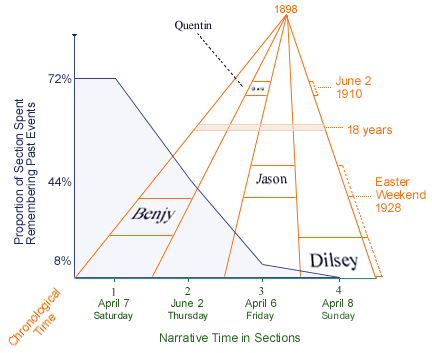 This
graph (contributed by Joel Deshaye) represents time in three different
dimensions. First, there is the sequence of four sections in the novel
- the narrative time or récit (shown in green). Second, there
is the chronology, l'histoire (shown in orange), beginning with
the earliest recollected date in the novel - Damuddy's death in 1898. These
two dimensions show how the conventional view of linear time can be disrupted
by a fictional narrative. Third, there is a representation of the proportion
of memories of and flashbacks to the past in each section (shown in blue).
This last dimension shows how the novel progresses from an emphasis on
the past toward an emphasis on the present. There is no future: as Dilsey
says, "I seed de beginnin, en now I sees de endin."
This
graph (contributed by Joel Deshaye) represents time in three different
dimensions. First, there is the sequence of four sections in the novel
- the narrative time or récit (shown in green). Second, there
is the chronology, l'histoire (shown in orange), beginning with
the earliest recollected date in the novel - Damuddy's death in 1898. These
two dimensions show how the conventional view of linear time can be disrupted
by a fictional narrative. Third, there is a representation of the proportion
of memories of and flashbacks to the past in each section (shown in blue).
This last dimension shows how the novel progresses from an emphasis on
the past toward an emphasis on the present. There is no future: as Dilsey
says, "I seed de beginnin, en now I sees de endin."
The blue proportional line does not discriminate between two very different
processes: the flashback and the memory. For instance, there are no memories
per se in Benjy's section; instead there is a collection of vivid
flashbacks linked to each other by association. Quentin's psychology is
very different, however, and in his section he narrates the present, his
memories, and his flashbacks. The intervals of remembered time in his narration
are made more difficult to categorize because some of his memories are
expository and some are so emotionally charged that they are nearly relived
memories or flashbacks.